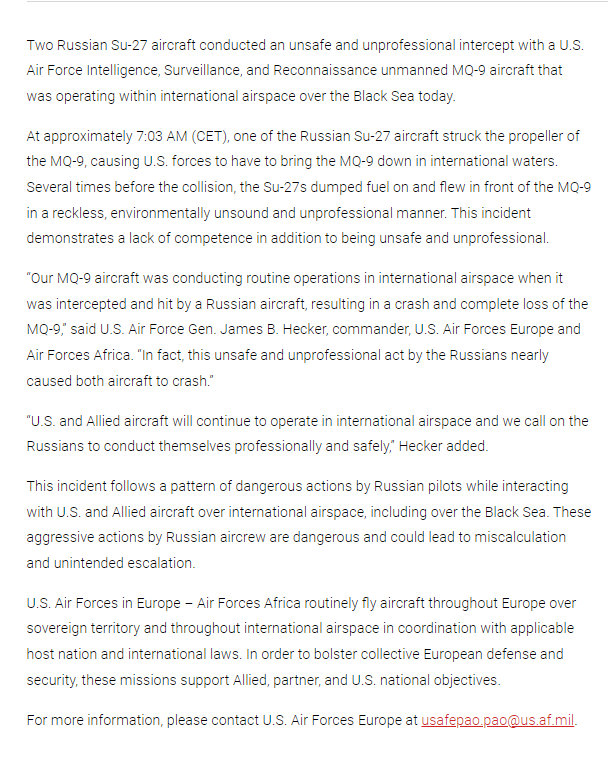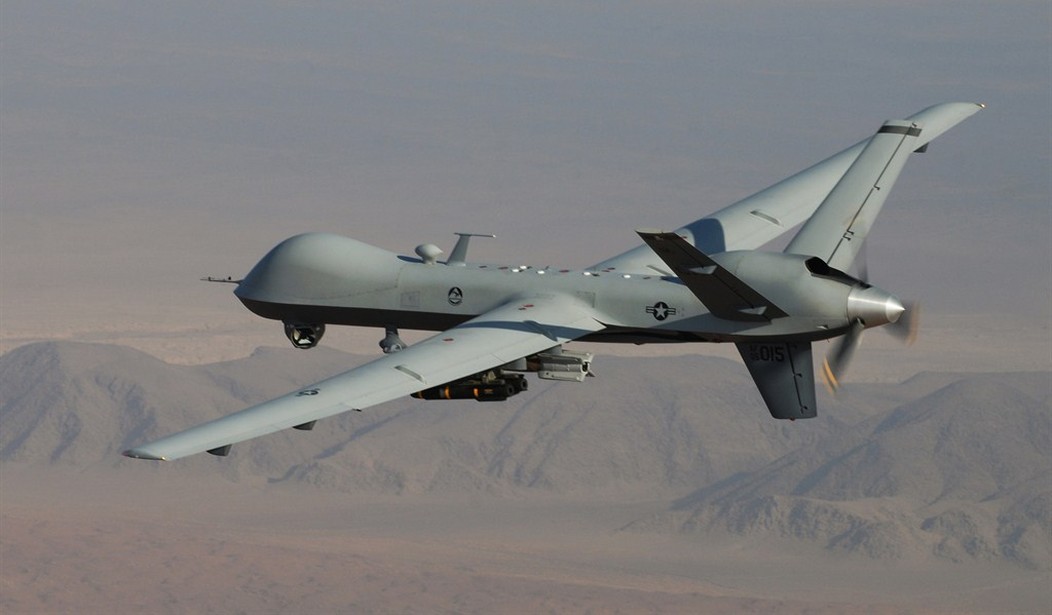A few hours ago, a pair of Russian Su-27 fighters intercepted an MQ-9 US reconnaissance drone in international airspace over the Black Sea. There are the predictable claims that this marks some sort of “escalation” that will lead to a clash between US and Russian forces. It could, but if the Russian Air Force has a functioning chain of command, it doesn’t have to.
During the five decades of the Cold War, US and Soviet fighter pilots routinely confronted one another wherever they encountered. The happenings often approximated this classic scene from the 1986 blockbuster movie Top Gun.
Sometimes things ended badly. According to the New York Times, at least a dozen US and USSR pilots died playing “chicken of the sea.” Often the skill did not match ambition.
In 1968, a Soviet Tupolev TU-16 reconnaissance plane crashed in the Mediterranean about five miles off the bow of the American aircraft carrier Essex after making four low passes over the ship. Since remains of the fliers and pieces of uniforms were recovered by the Essex, the Soviet Defense Ministry made one of its rare acknowledgments of the loss of a military plane. The Navy conceded that jets from the Essex were in the air at the time, but said they did not ”interfere with, hamper or threaten” the Soviet plane. The full Navy report on the incident remains classified.
With frequent interceptions, both sides developed a code of conduct to minimize risks.
Such incidents in the sky have been rare, an American admiral said, not because encounters have been infrequent but because in the great majority of cases the unwritten rules of aerial etiquette are observed in exquisite detail by both Soviet and American pilots. For instance, when Russian long-range bombers fly out of northern Russia on reconnaissance missions over United States ships in the Mediterranean, the bombers, like tame lions, open their bomb bays when intercepted, permitting American interceptor pilots to peer up into the bays and satisfy themselves that bombs or missiles are not being carried.
This is not to say it was bloodless. Any miscalculation that caused a reconnaissance aircraft to violate the USSR’s borders was liable to be shot down. On April 8, 1950, a US Navy PB4Y Privateer was shot down in international waters off Latvia with a loss of 10. Seventeen US servicemembers died on September 2, 1958, when their C-130 strayed over Soviet Armenia and was shot down. There were dozens of these incidents, and they did not result in anything more severe than an unpleasant diplomatic note. The most recent was the so-called Hainan Island Incident. A PLAF pilot, impossibly named “Wang Wei” (wang wei, indeed), let his reach exceed his grasp and collided with a US Navy EP-3 ARIES II signals intelligence plane. The PLAF pilot died, and the EP-3, with a crew of 24, was forced to make an emergency landing at a PLAF airbase.
According to National Security Council Spokesman John Kirby, this is not the first time the Russians have intercepted US drones over the Black Sea. Still, it is the first time the interception resulted in a collision.
General James Hecker, Commander US Air Force in Europe and Africa, James Hecker described an interception where the two Russian fighters dumped fuel in front of the drone, and then one collided with it. The drone crashed, and the Russian plane had to make an emergency landing. It seems to have been unprofessional, even by the standards of the Russian Air Force.

From the accounts available, this seems more like the case of two fighter pilots operating outside a rule set. But Russian pilots imagining they have more skill than they do is a fairly frequent occurrence. This is from just a year ago.
Amid tensions over a possible invasion of Ukraine, Russian aircraft intercepted U.S. Navy patrol planes in an “unprofessional” manner three separate times over the weekend, in one incident coming within five feet of an American plane, U.S. officials said Wednesday.
This Twitter thread has video of Russian intercepts of US aircraft going back three years.
A Tu-142MK ASW and a Tu-142MR strategic radio-relay aircraft conducted a 13 hour flight over the Barents, Norwegian, North Seas, and the Atlantic Ocean covering more than 10k km. They were intercepted by RAF Typhoon and Norwegian F-16 and F-35A fighters.https://t.co/mY58vYTi4r pic.twitter.com/WrkxnuS557
— Rob Lee (@RALee85) March 8, 2020
Where the danger starts is if the Russians claim the drones are providing targeting information to the Ukrainian Armed Forces. At that point, we either assert our right to freedom of navigation and start escorting the drones with fighter aircraft, we pull the drones from the Black Sea informally agreeing that it is a “Russian lake,” or we continue the mission and alter flight profiles to make it more interesting for the Russians.














Join the conversation as a VIP Member